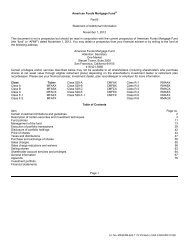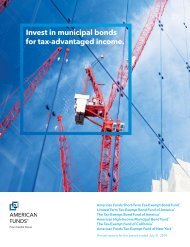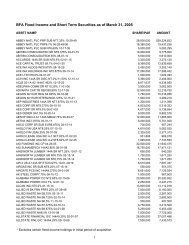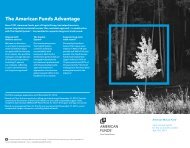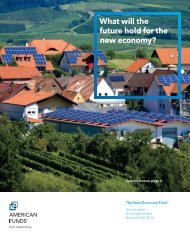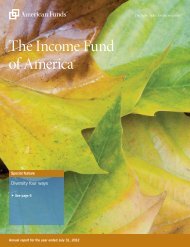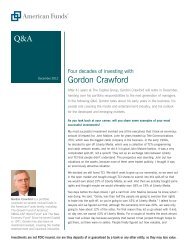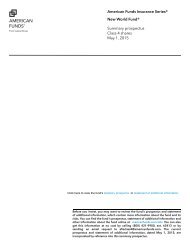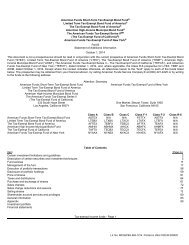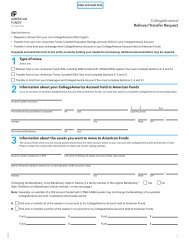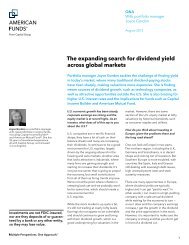Annual Report - American Balanced Fund - American Funds
Annual Report - American Balanced Fund - American Funds
Annual Report - American Balanced Fund - American Funds
Create successful ePaper yourself
Turn your PDF publications into a flip-book with our unique Google optimized e-Paper software.
AMBAL’s asset allocation in actionAMBAL’s balance of equity and fixed-income investments can be re-alignedto more effectively pursue the fund’s objectives. “If you look at the fund’sallocation over time,” suggests Portfolio Manager Jim Mulally, “you’ll seethat it adjusts to economic and market conditions — not in a daily, tacticalway but as a strategic mix.” Consider these two different points in history:1999: Potentially overvalued market 2013: Strong market growthWall Street closed its books on acentury of unprecedented growthwith the Dow Jones IndustrialAverage, the Nasdaq CompositeIndex and Standard & Poor’s 500Composite Index reaching recordhighs. Already concerned about thesustainability of high stock valuations,AMBAL’s portfolio managers kept thefund’s portfolio close to the levelsthey had set in 1996 — ending the yearjust 57% in equities (with 34% in fixedincome and 9% in cash).9% 3%Five years after a devastating crash,the equity market had not onlyrecovered, it rewarded those whoremained invested with substantialgrowth. The Dow and the S&P 500posted their largest gains since thelate 1990s. The Nasdaq rose almost40% to levels it hadn’t reached since2000. In order to help investorstake advantage of the strong 2013market, AMBAL maintained an equityallocation over 70%, ending the yearalmost 74% invested in equities (23%in fixed income and 3% in cash).23%Two keys to AMBAL’s success are itsasset allocation strategy and time-testedinvestment process called The CapitalSystem ṢMAMBAL’s dynamic asset allocationstrategyMany balanced funds available todayremain at a target asset allocation ofapproximately 60% equities and 40%fixed-income securities, regardless ofmarket environment.In contrast, AMBAL seeks a betterbalance at any given point in timethrough built-in flexibility. “By design,”explains Greg, “equities can accountfor as much as 75% and no less than 50%of the AMBAL portfolio. Sometimes,we’ve found that 65% in equities and35% in fixed-income and cash is wherewe need to be to effectively pursue thefund’s objectives. There are, however,times when it may be more prudent tomove that allocation to one extreme orthe other.”34%57%74%According to Greg, “There are anumber of factors we consider as weassess where AMBAL should be in termsof asset allocation, including equityvaluations, the term structure of interestrates and our fixed-income professionals’forecasts on the direction of rates.”Total equities Total fixed income Cash & equivalentsSource: Capital Group (as of December 31, 2013).A time-tested systemBalance can be a very personalconcept. <strong>American</strong> <strong>Fund</strong>s understandsthe value of individual perspectives,even within the structure of a commonobjective. In AMBAL, as with all of the<strong>American</strong> <strong>Fund</strong>s, a combination of8 <strong>American</strong> <strong>Balanced</strong> <strong>Fund</strong>




